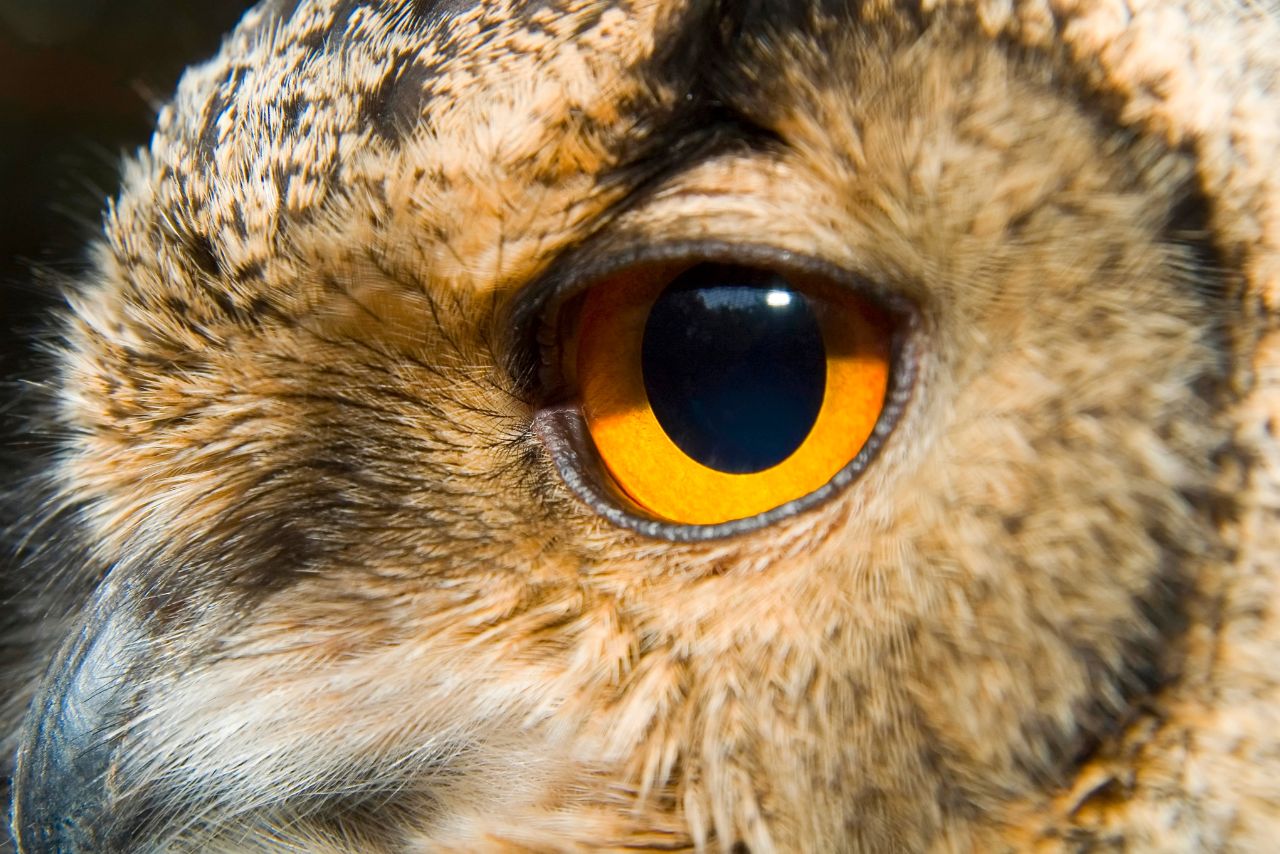Do owls have eyeballs? Yes, they do! Owls are fascinating creatures known for their unique adaptations, and their eyes are no exception.
With large, forward-facing eyes that seem to pierce the darkness of night, owls possess some remarkable features that enable them to be exceptional hunters.
In this article, we will explore the intriguing world of owl eyes and discover how these magnificent birds use their incredible vision to survive and thrive in various habitats.
So let’s dive into the mesmerizing realm of owl eyeballs and uncover the secrets behind their extraordinary visual abilities!
Do Owls Really Have Eyeballs?
Yes, owls do have eyeballs. But they are not like the eyeballs of humans or other animals. Owls’ eyeballs are elongated and tube-shaped, and they are held in place by bony structures called sclerotic rings.
This makes it impossible for owls to move their eyes within their sockets. Instead, owls have to move their heads in order to look around.
Owls’ eyes are also very large, relative to their body size. This allows them to collect more light, which is important for seeing in low light conditions.
Owls also have a special layer of tissue in their eyes called the tapetum lucidum, which reflects light back through the retina, further enhancing their night vision.
The Anatomy of an Owl’s Eye
Owls have fascinating eyes that are specifically adapted to their nocturnal lifestyle. Here is a breakdown of the anatomy of an owl’s eye:
- Large Size: Owls have comparatively large eyes, which allow them to gather as much light as possible in dim conditions.
- Forward-Facing Placement: The placement of owl’s eyes on the front of their face gives them binocular vision, enabling accurate depth perception and precise hunting.
- Tubular Shape: Owl’s eyeballs are elongated and tube-shaped rather than spherical like human eyeballs.
- Fixed Position: Unlike humans, owls cannot move their eyeballs within the sockets because they lack eye muscles.
- Immobility compensated by extraordinary adaptations:
- Binocular Vision: Owls compensate for immobile eyes by having a fixed gaze forward; this allows both their eyes to focus on one spot simultaneously, resulting in excellent depth perception.
- Flexible Neck: To compensate for limited eye movement, owls possess highly flexible necks that can rotate up to 270 degrees in either direction, allowing them to scan their surroundings without moving their bodies excessively.
- Owl Eyelids:
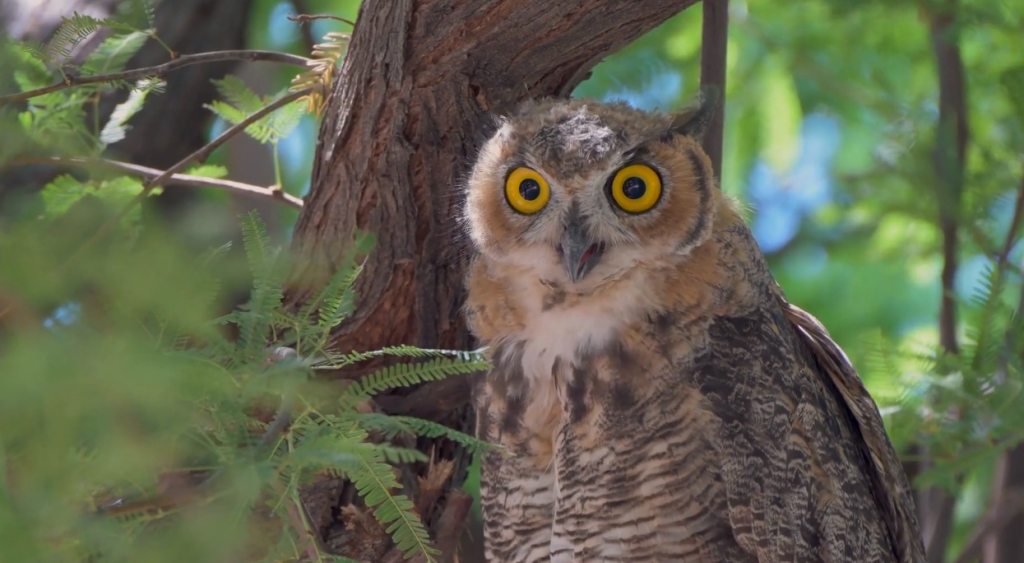
- Upper Eyelid: Owls have upper eyelids that close from top-down when blinking or sleeping; these eyelids are transparent and protect the owl’s delicate cornea while still allowing it to see through partially closed lids.
- Lower Eyelid: In addition to the upper eyelid, owls also possess a lower eyelid called a “nictitating membrane,” which helps protect the eye while maintaining visibility during flight or capturing prey.
- Retina Structure: The retina at the back of an owl’s eye contains specialized cells called rods and cones that contribute to exceptional night vision.
- Tapetum Lucidum: Owls possess a reflective layer called the “tapetum lucidum” behind their retina. This structure enhances their ability to see in low light by reflecting light back through the retina, giving it a second chance to be detected.
What Is True About Owl Eyes?
Owls’ eyes are not true eyeballs. They are elongated and tube-shaped, and they are held in place by bony structures called sclerotic rings. Owls’ eyes are very large, relative to their body size.
This allows them to collect more light, which is important for seeing in low light conditions.
Owls have a special layer of tissue in their eyes called the tapetum lucidum, which reflects light back through the retina, further enhancing their night vision. Owls can rotate their heads 270 degrees.
This allows them to look around without having to move their bodies. Owls have excellent hearing. They have asymmetrical ears, which allows them to pinpoint the location of sounds very accurately.
How Many Eyes Does a Owl Have?
wls have two eyes, just like humans. However, their eyes are very large and forward-facing, which gives them excellent binocular vision.
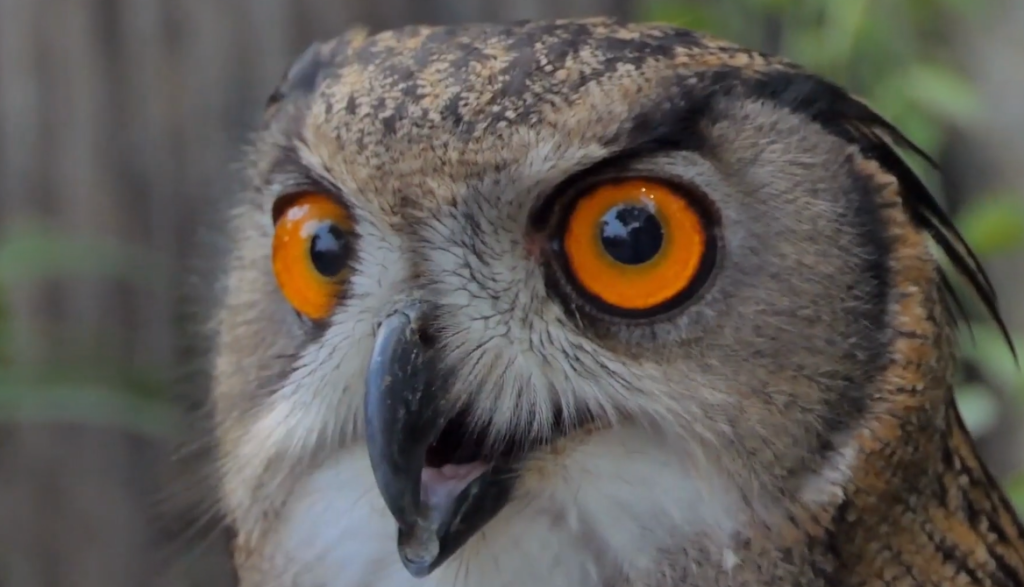
This means that they can see objects in three dimensions, which is essential for hunting in low light conditions.
Why Is Owl Eyes so Impressed?
Owl eyes are impressive because they are perfectly adapted for seeing in low light conditions. Here are some of the reasons why owl eyes are so impressive:
- Owls’ eyes are very large, relative to their body size. This allows them to collect more light, which is important for seeing in low light conditions.
- Owls have a special layer of tissue in their eyes called the tapetum lucidum, which reflects light back through the retina, further enhancing their night vision.
- Owls can rotate their heads 270 degrees. This allows them to look around without having to move their bodies.
- Owls have excellent hearing. They have asymmetrical ears, which allows them to pinpoint the location of sounds very accurately.
Does Owl Sleep with Eyes Open?
Owls do not sleep with their eyes completely open, but they do sleep with their eyes partially open.
This is because they have large eyes that cannot move within their sockets, so they need to keep their eyes open to maintain a lookout for predators or prey.
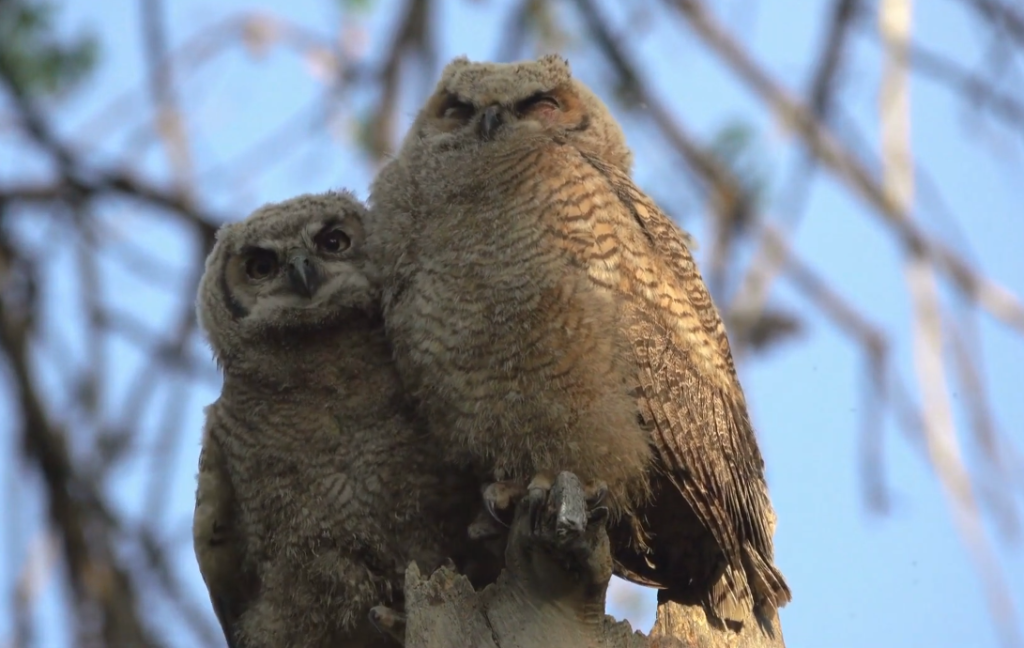
Owls also have a special adaptation called unihemispheric slow-wave sleep, which allows them to sleep with one eye open while the other eye remains alert.
This allows owls to stay aware of their surroundings even while they are sleeping, which is important for their survival.
Does Owl Have 3d Vision?
Yes, owls have 3D vision. They have forward-facing eyes that are positioned close together, which gives them a wide field of binocular vision.
This allows them to see objects in three dimensions, which is essential for hunting in low light conditions.
In addition to their forward-facing eyes, owls also have a special layer of tissue in their eyes called the tapetum lucidum. This layer reflects light back through the retina, further enhancing their night vision.
How Owls Use Their Eyes to Hunt?
- Exceptional Night Vision: Owls have incredibly powerful eyesight that allows them to see in low light conditions. They possess a high number of rod cells in their retinas, which are specialized for detecting dim light. This gives them exceptional night vision and enables them to hunt effectively in the dark.
- Large Binocular Field: The position of owls’ eyes on the front of their heads provides them with excellent depth perception and a large binocular field of view. This means they can accurately judge distances and precisely locate prey even from a distance.
- Fixed Eyeballs: Unlike humans or many other animals, owls cannot move their eyeballs within their eye sockets. Instead, they have evolved to compensate by having flexible necks that can rotate up to 270 degrees. This rotation allows owls to scan their surroundings without moving their eyes significantly.
- Enhanced Peripheral Vision: While owls have limited ability to move their eyes, they make up for it with an enhanced peripheral vision range. Their wide visual field allows them to detect movements happening around them more easily, making it difficult for potential prey or predators trying to approach unnoticed.
- Sharp Focus and Depth Perception: Owl’s eyes are uniquely designed for precise focusing over long distances. They achieve this through several adaptations including an elongated tubular shape of the eyeball and multiple lenses within each eye. These adaptations enable sharp focus on distant objects while still maintaining good depth perception when hunting close-range targets.
Night Vision: The Secret Behind Owl’s Eyeballs
- Owls possess incredible night vision capabilities that allow them to navigate and hunt in the dark.
- Their unique ability is primarily attributed to their specialized eyeballs and other adaptations.
- Here are some key factors contributing to the exceptional night vision of owls:
- Large Eyes: Owls have large eyes relative to their body size, providing them with a greater light-gathering capacity.
- Binocular Vision: The positioning of an owl’s eyes on the front of its face enables binocular vision, allowing for precise depth perception and accurate distance estimation even in low-light conditions.
- Forward-Facing Eyes: Unlike many other birds, which typically have eyes on the sides of their head, an owl’s forward-facing eyes provide a wider field of view without needing to move its head extensively.
- Tubular Shape: An owl’s eyeball has a tubular shape rather than being spherical like human eyeballs. This elongated structure enhances visual sharpness by focusing light more effectively onto the retina.
- High Number of Rod Cells: Rod cells are photoreceptor cells responsible for detecting low levels of light. Owls possess a high density of rod cells in their retinas, enhancing their sensitivity to dim illumination.
- Tapetum Lucidum: Another remarkable feature is the presence of tapetum lucidum behind an owl’s retina—a reflective layer that aids in maximizing available light by reflecting it back through the retina for a second chance at detection.
- Enhanced Blood Supply: A rich blood supply nourishes an owl’s highly active retinal tissue, ensuring optimal functioning and increased visual acuity under challenging lighting conditions.
- Adapted Pupils: Owl pupils can dilate widely to gather as much incoming light as possible during nighttime activities while contracting during daylight hours to protect their sensitive retinas.
Fascinating Facts About Owl Vision
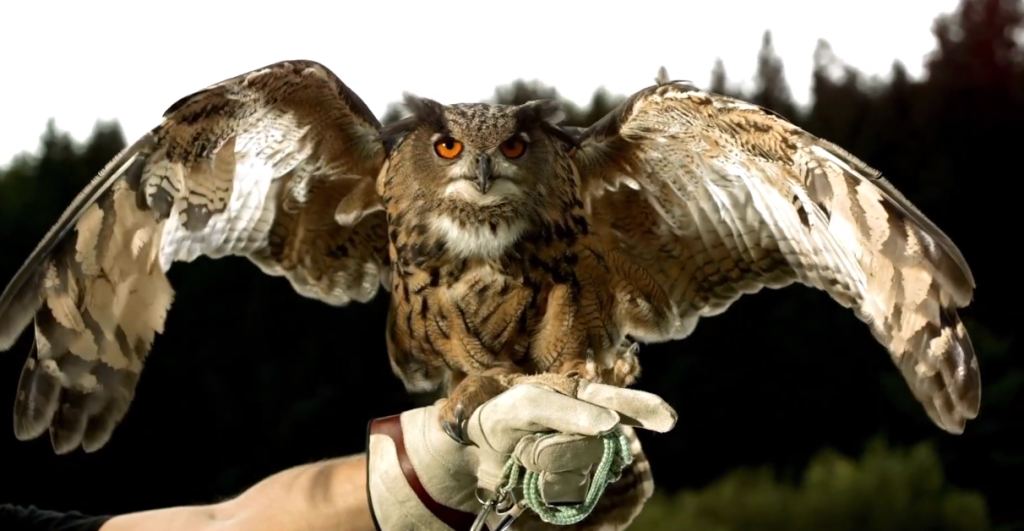
Owls are known for their incredible vision, which enables them to hunt and navigate in low-light conditions. Here are some fascinating facts about owl vision:
- Binocular Vision: Owls have forward-facing eyes that provide binocular vision, allowing them to focus on objects with great precision. This gives them depth perception and helps in accurately judging distances while hunting.
- Large Eyes: Owls have relatively large eyes compared to the size of their heads. In fact, an owl’s eyeballs can be almost as big as human eyeballs! These large eyes gather more light, enhancing their ability to see clearly even in dim lighting.
- Fixed Eyeballs: Unlike humans and many other animals, owls cannot move their eyeballs within the eye sockets. Instead, they compensate for this limitation by having flexible necks that can rotate up to 270 degrees! This allows them to scan a larger area without moving their bodies.
- Nocturnal Adaptations: Owls are primarily nocturnal creatures, meaning they are most active during the night-time hours. To aid their night vision capabilities further, owls have a high concentration of rod cells (photoreceptor cells) in their retinas that help detect low levels of light.
- Excellent Depth Perception: The positioning of an owl’s eyes on the front of its face provides excellent depth perception an essential visual skill when it comes to capturing prey mid-flight or navigating through dense forest environments.
- Ultra-sensitive Retinas: Owl retinas contain a higher number of light-sensitive cells called rods than cones compared to humans’ retinas. These rods allow owls to detect even the slightest movements and track fast-flying prey accurately.
- Asymmetrically Arranged Ears: Although not directly related to vision per se, an interesting aspect of owl anatomy is how they use their ears to locate prey accurately. One ear is positioned higher than the other, allowing them to triangulate sounds and pinpoint the exact location of potential meals.
Watch Video: Do Owls Really Have Eyeballs?
Conclusion! Do Owls Really Have Eyeballs?
Owls do have eyeballs. These remarkable creatures possess a unique set of eyes that are perfectly adapted to their nocturnal lifestyle.
Unlike humans and many other animals, owls have large forward-facing eyes that provide them with exceptional binocular vision.
The structure of an owl’s eyeball is also quite fascinating. It is much larger in proportion to its head compared to most birds, allowing for greater light-gathering capability.
The size and position of the eyeballs enable the owl to see clearly in low-light conditions, making them highly efficient hunters during nighttime.
FAQs
Do Owls Have Big Eyes?
Yes, owls have very large eyes, relative to their body size.
This allows them to collect more light, which is important for seeing in low light conditions.
The eyes of a Great Horned Owl, for example, are about the size of a human’s grapefruit.
Can Owls Move Their Eyeballs?
No, owls cannot move their eyeballs within their sockets. Instead, they have to move their heads in order to look around.
This is because their eyeballs are elongated and tube-shaped, and they are held in place by bony structures called sclerotic rings.
Why Do Owls Have Big Eyes?
Owls have big eyes to collect more light. This is important for seeing in low light conditions, as owls are nocturnal predators.
The larger the eye, the more light it can collect.
What Is the Tapetum Lucidum?
The tapetum lucidum is a reflective layer in the back of the owl’s eye. It reflects light back through the retina, further enhancing the owl’s night vision.
The tapetum lucidum is what gives owls their characteristic “glowing eyes” in the dark.
How Many Eyeballs Do Owls Have?
Owls have two eyeballs, just like humans. However, their eyes are very large and forward-facing, which gives them excellent binocular vision.
This means that they can see objects in three dimensions, which is essential for hunting in low light conditions.

